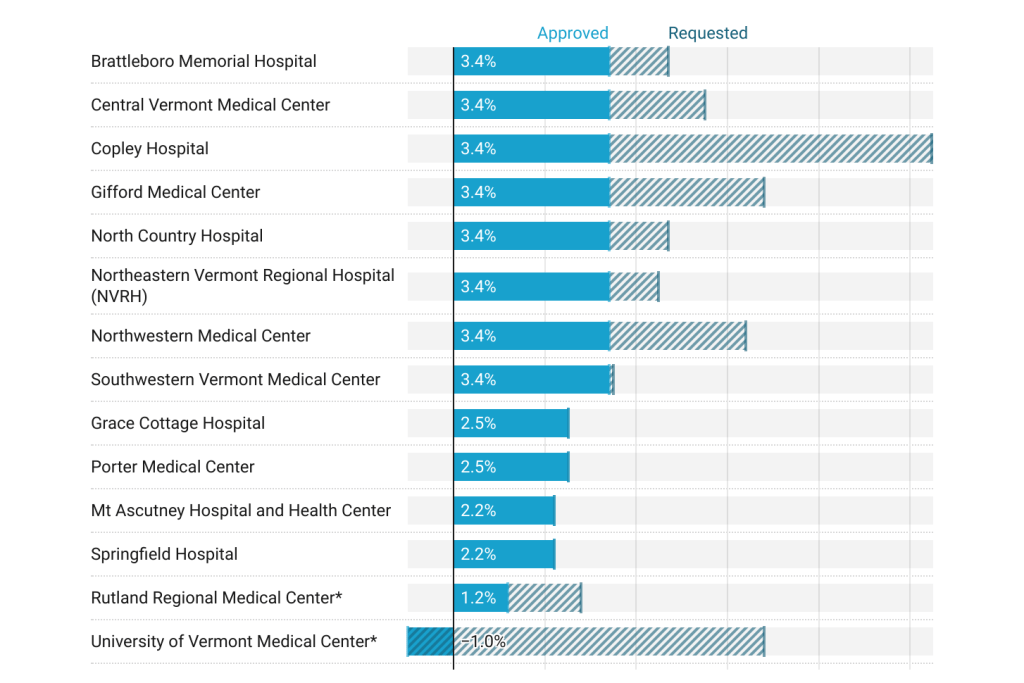A key Vermont health care regulator reduced hospital budgets by millions of dollars for the 2025 fiscal year, setting out financial guardrails for how the facilities can operate over the next 12 months.
The decisions, announced Friday by the Green Mountain Care Board, place caps on how much Vermont hospitals can charge for services and how much revenue they can bring in from those services.
Earlier this year, Vermont’s hospitals asked the board to sign off on a 5.7% systemwide increase in charges for patient care to private insurers, such as Blue Cross Blue Shield and MVP. Hospitals sought to raise their patient revenue — money brought in from caring for patients — by a total of 8%.
But the board capped overall commercial charge growth for patient care at an increase of 3.4% or less over the current fiscal year for each hospital. And revenue from patient services can grow only 4.1% systemwide in the next fiscal year, per the board’s orders.
The decisions will take effect in hospitals’ 2025 fiscal year, which begins Oct. 1.
Owen Foster, the chair of the Green Mountain Care Board, said in an interview Monday that the board’s decisions were an attempt to balance competing concerns: affordability, access and the viability of the state’s hospitals.
“The big theme was really considering the system and what’s going on in the insurance market and with people’s ability to afford health care,” Foster said in an interview Monday. “While also being mindful that we’re on the precipice of, potentially, some large systematic change.”
Earlier this year, the Green Mountain Care Board signed off on a third year of substantial increases for commercial insurance premiums — a move that has added fuel to concerns about the cost of health care in the state.
That potential “systematic change” mentioned by Foster refers to a report due Wednesday by a consultant with recommendations for how Vermont’s hospitals should adapt to ensure the long-term sustainability of the state’s health care system.
But Mike Del Trecco, the president and CEO of the Vermont Association of Hospitals and Health Systems, said the board’s cuts could harm health care access in the state.
“We know we live in a state where the cost of everything is high — housing, property taxes, groceries, health care — and we’ve got to work on putting pressure on those costs and bringing them down,” Del Trecco said. “But we also live in a state with a very old population, and those Vermonters need more care, and frankly, it’s more expensive care. And that’s the balancing act we’re faced with.”
Changes to charges for hospital services
The care board set benchmark increases of 3.5% for patient revenue and 3.4% for hospital charges to commercial insurers, based on state health care affordability goals.
In their decisions, the board kept all hospitals’ charges for patient care within or below that 3.4% cap.
In the case of the University of Vermont Medical Center, the state’s largest hospital, the board actually required a 1% decrease in charges in 2025 — a response to the fact that, in its 2023 fiscal year, the hospital had exceeded its board-ordered patient revenue cap. The Burlington hospital had requested permission to raise prices by 6.8%.
UVM Health Network administrators have said that that excess revenue came from treating more patients with more complex needs — and that the hospital actually lost money on providing that care.
“On Friday, the Board informed UVM Health Network that they would be penalizing the Network for providing increased care to our patients,” UVM Health Network spokesperson Annie Mackin said in an emailed statement, “and enforcing a cap on care by allowing commercial insurance companies to pay us less in the coming two years than they did last year, even as the costs of providing health care continue to increase.”
Rutland Regional Medical Center, which also exceeded its board-ordered revenue that year, will be held to a 1.2% bump in charges — less than half its requested hike of 2.8%.
All other hospitals were allowed to raise prices between 2.2% and 3.4%.
Patient revenue changes
The board-allowed increase in patient services revenue came out to 4.1% across all hospitals, but individual hospital caps varied more widely.
North Country Hospital will be allowed to grow patient revenue by 1.6%, the amount requested by the Newport hospital. Meanwhile, Morrisville’s Copley Hospital will be allowed to raise patient revenue by 9%, and Northwestern Medical Center, in St. Albans, can raise revenue by 6.8%, the two largest adjustments in the state.
Foster, the Green Mountain Care Board chair, said that those higher revenue caps will allow the hospitals — both of which are, he said, relatively affordable — to treat more patients.
“Copley and Northwestern are, by Vermont standards, quite a bit more affordable for services on the commercial side,” he said. “And so we gave both of them quite a bit more than the guidance was to allow that affordable access.”
Hospitals are able to appeal the board’s orders on their budgets, although Del Trecco said he was unaware of any current efforts to appeal the decisions.
But University of Vermont Health Network president and CEO Sunny Eappen said in an interview last week that the network was exploring legal options to challenge the board’s orders, which he said could force hospitals to cut services.
“We will explore every possible venue to protect Vermonters in doing this work,” he said.
Read the story on VTDigger here: Green Mountain Care Board trims hospital requests for increases to 2025 budget, service charges.

